1 Flume事务
一提到事务,首先就想到的是关系型数据库中的事务,事务一个典型的特征就是将一批操作做成原子性的,要么都成功,要么都失败。
flume事务就是保证fllume能安全正常的运行,保证服务的可靠性,安全性。
在Flume中一共有两个事务:
- Put事务:在Source到Channel之间
- Take事务:Channel到Sink之间
从Source到Channel过程中,数据在Flume中会被封装成Event对象,也就是一批Event,把这批Event放到一个事务中,把这个事务也就是这批event一次性的放入Channel中。同理,Take事务的时候,也是把这一批event组成的事务统一拿出来到sink放到HDFS上。
事务具体流程如下图所示:
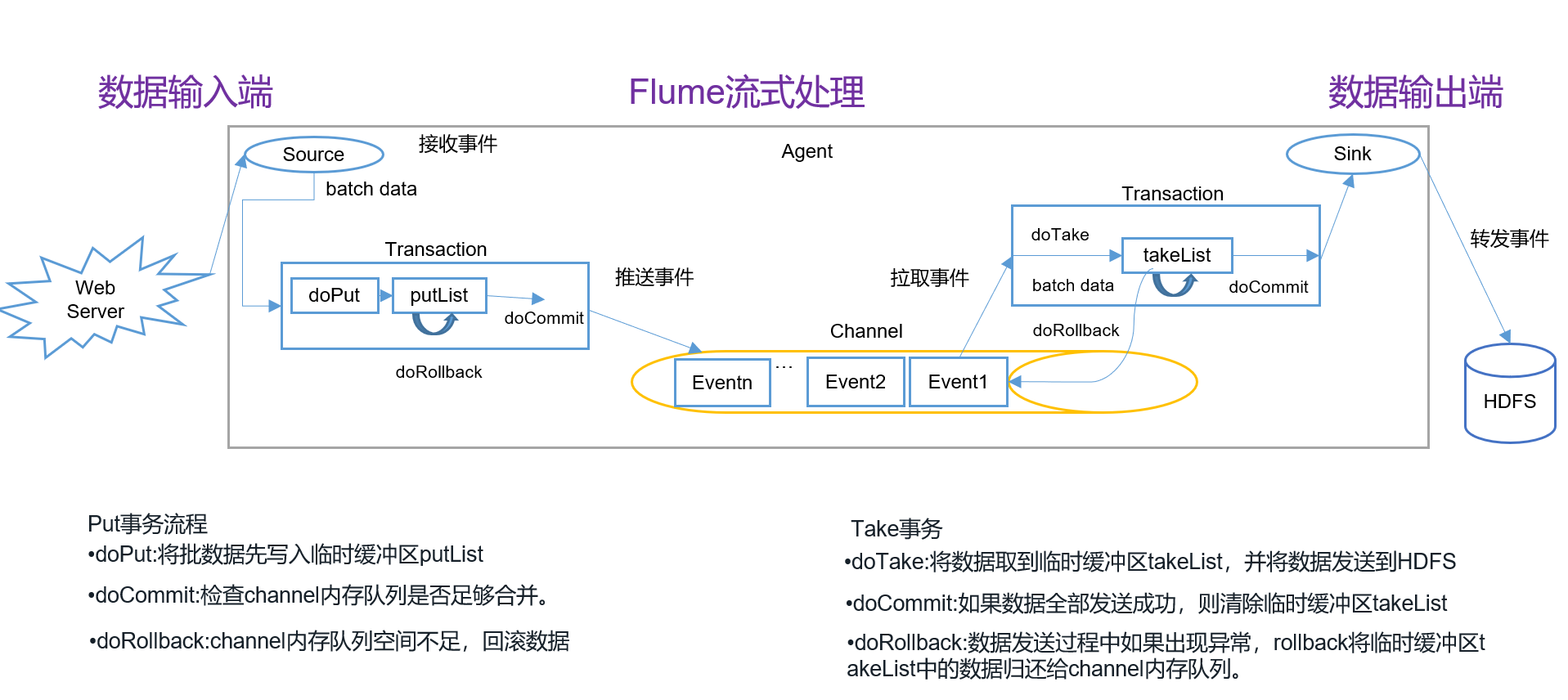
1.1 Put事务流程
事务开始的时候会调用一个doPut 方法,doPut方法将一批数据放在putList中;
- putList在向Channel发送数据之前先检查Channel的容量能否放得下,如果放不下一个都不放,只能doRollback;
- 数据批的大小取决于配置参数batch size的值;
- putList的大小取决于配置Channel的参数transaction capacity的大小,该参数大小就体现在putList上;(Channel的另一个参数capacity指的是Channel的容量);
数据顺利的放到putList之后,Flume中的 Take 事务
Take事务同样也有takeList,HDFS sink配置有一个batch size,这个参数决定Sink从Channel 取数据的时候一次取多少个,所以该batch size得小于takeList的大小,而takeList的大小取决于 transaction capacity 的大小,同样是channel中的参数。其中putlist,takelist容量可以通过下面配置:a3.channels.c3.transactionCapacity = 100
1.2 Take事务流程:
事务开始后
doTake方法会将channel中的event剪切到takeList中。如果后面接的是HDFS Sink的话,在把Channel中的event剪切到takeList中的同时也往写入HDFS的IO缓冲流中放一份event(数据写入HDFS是先写入IO缓冲流然后flush到HDFS);
当takeList中存放了batch size 数量的event之后,就会调用doCommit方法,doCommit方法会做两个操作:
- 针对HDFS Sink,手动调用IO流的flush方法,将IO流缓冲区的数据写入到HDFS磁盘中;
- 清空takeList中的数据
flush到HDFS的时候组容易出问题。flush到HDFS的时候,可能由于网络原因超时导致数据传输失败,这个时候调用doRollback方法来进行回滚,回滚的时候由于takeList中还有备份数据,所以将takeList中的数据原封不动地还给channel,这时候就完成了事务的回滚。
但是,如果flush到HDFS的时候,数据flush了一半之后出问题了,这意味着已经有一半的数据已经发送到HDFS上面了,现在出了问题,同样需要调用doRollback方法来进行回滚,回滚并没有“一半”之说,它只会把整个takeList中的数据返回给 channel,然后继续进行数据的读写。这样开启下一个事务的时候容易造成数据重复的问题。接下来可以调用doCommit方法,把putList中所有的Event放到 Channel 中,成功放完之后就清空putList;
在doCommit提交之后,事务在向Channel存放数据的过程中,事务容易出问题。如Sink取数据慢,而Source放数据速度快,容易造成Channel中数据的积压,如果putList中的数据放不进去,会如何呢?
此时会调用 doRollback 方法,doRollback方法会进行两项操作:将putList清空; 抛出 ChannelException异常。source会捕捉到doRollback抛出的异常,然后source就将刚才的一批数据重新采集,然后重新开始一个新的事务,这就是事务的回滚。
2 Flume Agent内部原理
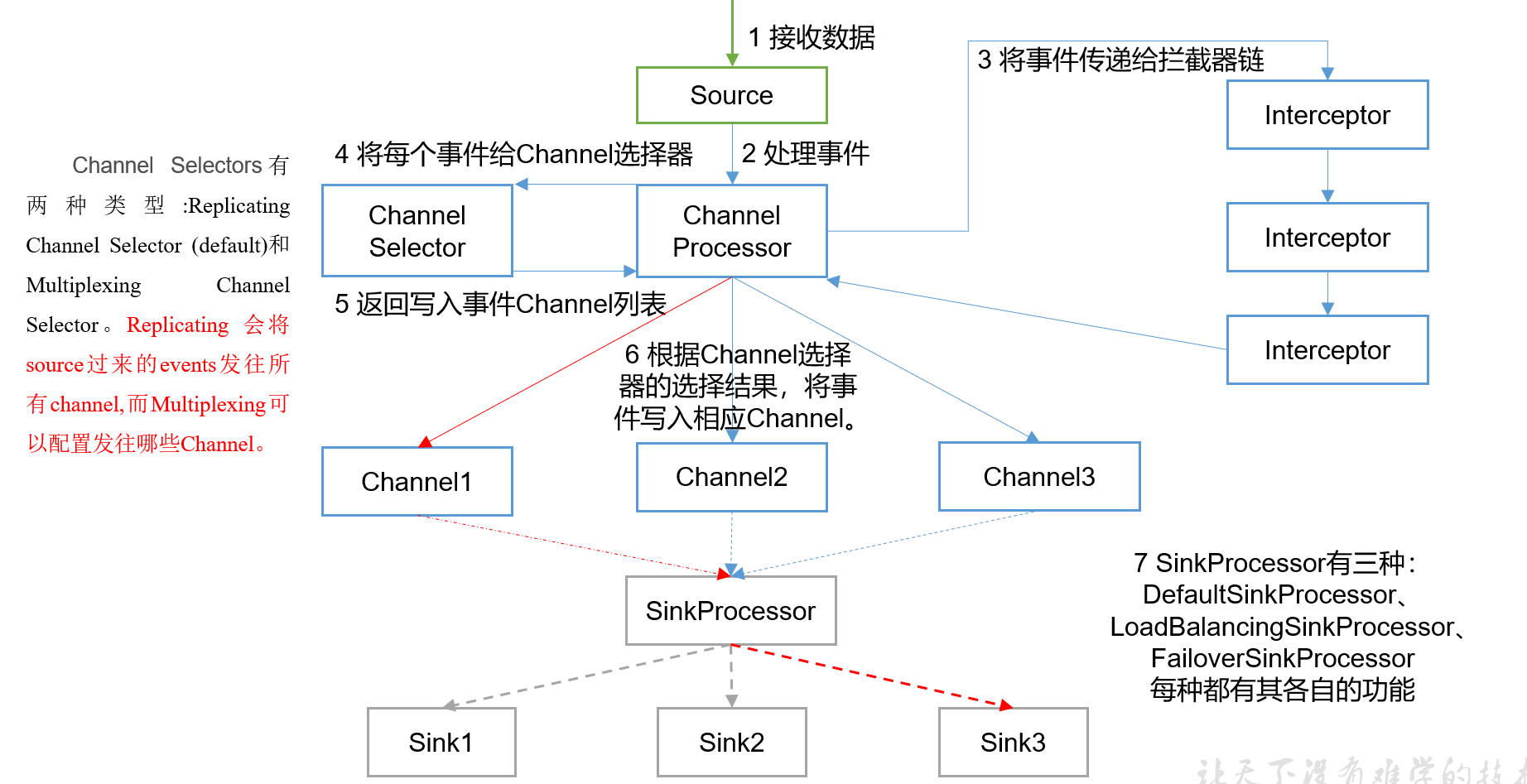
重要组件:
1)ChannelSelector
ChannelSelector的作用就是选出Event将要被发往哪个Channel。其共有两种类型,分别是Replicating(复制)和Multiplexing(多路复用)。
ReplicatingSelector会将同一个Event发往所有的Channel,Multiplexing会根据相应的原则,将不同的Event发往不同的Channel。
2)SinkProcessor
SinkProcessor共有三种类型,分别是DefaultSinkProcessor、LoadBalancingSinkProcessor和FailoverSinkProcessor
DefaultSinkProcessor对应的是单个的Sink,LoadBalancingSinkProcessor和FailoverSinkProcessor对应的是Sink Group,
LoadBalancingSinkProcessor可以实现负载均衡的功能:利用一定算法将channel均衡的分配到sink上;
FailoverSinkProcessor可以错误恢复的功能:三个中只有一个是Active的sink,如果当前acticve的sink故障了,另外两台通过选举的方式上位,成为新的sink(选举的指标是配置文件中a1.sinkgroups.g1.processor.priority.k1)。
3 Flume拓扑结构
在实际应用中,根据不同的场景,可能部署多个flume实现功能,很多个flume使用的搭配结果如下:
3.1 简单串联

这种模式是将多个flume顺序连接起来了,从最初的source开始到最终sink传送的目的存储系统。此模式不建议桥接过多的flume数量, flume数量过多不仅会影响传输速率,而且一旦传输过程中某个节点flume宕机,会影响整个传输系统。
3.2 复制和多路复用

Flume支持将事件流向一个或者多个目的地。这种模式可以将相同数据复制到多个channel中,或者将不同数据分发到不同的channel中,sink可以选择传送到不同的目的地。
3.3 负载均衡和故障转移

Flume支持使用将多个sink逻辑上分到一个sink组,sink组配合不同的SinkProcessor可以实现负载均衡和错误恢复的功能。
3.4 聚合

这种模式是我们最常见的,也非常实用,日常web应用通常分布在上百个服务器,大者甚至上千个、上万个服务器。产生的日志,处理起来也非常麻烦。用flume的这种组合方式能很好的解决这一问题,每台服务器部署一个flume采集日志,传送到一个集中收集日志的flume,再由此flume上传到hdfs、hive、hbase等,进行日志分析。
4 Flume开发案例
4.1 复制
1)案例需求
使用Flume-1监控文件变动,Flume-1将变动内容传递给Flume-2,Flume-2负责存储到HDFS。同时Flume-1将变动内容传递给Flume-3,Flume-3负责输出到Local FileSystem。
2)需求分析:

具体类型选择如下图所示:

3)实现步骤:
(1)准备工作
在/opt/module/flume/job目录下创建group1文件夹
[molly@hadoop102 job]$ cd group1/在/opt/module/datas/目录下创建flume3文件夹
[molly@hadoop102 datas]$ mkdir flume3(2)创建flume-file-flume.conf
配置1个接收日志文件的source和两个channel、两个sink,分别输送给flume-flume-hdfs和flume-flume-dir。
编辑配置文件
[molly@hadoop102 group1]$ vim flume-file-flume.conf添加如下内容
# Name the components on this agent
a1.sources = r1
a1.sinks = k1 k2
a1.channels = c1 c2
# 将数据流复制给所有channel
a1.sources.r1.selector.type = replicating
# Describe/configure the source
a1.sources.r1.type = exec
a1.sources.r1.command = tail -F /opt/module/hive/logs/hive.log
a1.sources.r1.shell = /bin/bash -c
# Describe the sink
# sink端的avro是一个数据发送者
a1.sinks.k1.type = avro
a1.sinks.k1.hostname = hadoop102
a1.sinks.k1.port = 4141
a1.sinks.k2.type = avro
a1.sinks.k2.hostname = hadoop102
a1.sinks.k2.port = 4142
# Describe the channel
a1.channels.c1.type = memory
a1.channels.c1.capacity = 1000
a1.channels.c1.transactionCapacity = 100
a1.channels.c2.type = memory
a1.channels.c2.capacity = 1000
a1.channels.c2.transactionCapacity = 100
# Bind the source and sink to the channel
a1.sources.r1.channels = c1 c2
a1.sinks.k1.channel = c1
a1.sinks.k2.channel = c2(3)创建flume-flume-hdfs.conf
配置上级Flume输出的Source,输出是到HDFS的Sink。
编辑配置文件
[molly@hadoop102 group1]$ vim flume-flume-hdfs.conf添加如下内容
# Name the components on this agent
a2.sources = r1
a2.sinks = k1
a2.channels = c1
# Describe/configure the source
# source端的avro是一个数据接收服务
a2.sources.r1.type = avro
a2.sources.r1.bind = hadoop102
a2.sources.r1.port = 4141
# Describe the sink
a2.sinks.k1.type = hdfs
a2.sinks.k1.hdfs.path = hdfs://hadoop102:8020/flume2/%Y%m%d/%H
#上传文件的前缀
a2.sinks.k1.hdfs.filePrefix = flume2-
#是否按照时间滚动文件夹
a2.sinks.k1.hdfs.round = true
#多少时间单位创建一个新的文件夹
a2.sinks.k1.hdfs.roundValue = 1
#重新定义时间单位
a2.sinks.k1.hdfs.roundUnit = hour
#是否使用本地时间戳
a2.sinks.k1.hdfs.useLocalTimeStamp = true
#积攒多少个Event才flush到HDFS一次
a2.sinks.k1.hdfs.batchSize = 100
#设置文件类型,可支持压缩
a2.sinks.k1.hdfs.fileType = DataStream
#多久生成一个新的文件
a2.sinks.k1.hdfs.rollInterval = 600
#设置每个文件的滚动大小大概是128M
a2.sinks.k1.hdfs.rollSize = 134217700
#文件的滚动与Event数量无关
a2.sinks.k1.hdfs.rollCount = 0
# Describe the channel
a2.channels.c1.type = memory
a2.channels.c1.capacity = 1000
a2.channels.c1.transactionCapacity = 100
# Bind the source and sink to the channel
a2.sources.r1.channels = c1
a2.sinks.k1.channel = c1(4)创建flume-flume-dir.conf
配置上级Flume输出的Source,输出是到本地目录的Sink。
编辑配置文件
[molly@hadoop102 group1]$ vim flume-flume-dir.conf添加如下内容
# Name the components on this agent
a3.sources = r1
a3.sinks = k1
a3.channels = c2
# Describe/configure the source
a3.sources.r1.type = avro
a3.sources.r1.bind = hadoop102
a3.sources.r1.port = 4142
# Describe the sink
a3.sinks.k1.type = file_roll
a3.sinks.k1.sink.directory = /opt/module/data/flume3
# Describe the channel
a3.channels.c2.type = memory
a3.channels.c2.capacity = 1000
a3.channels.c2.transactionCapacity = 100
# Bind the source and sink to the channel
a3.sources.r1.channels = c2
a3.sinks.k1.channel = c2提示:输出的本地目录必须是已经存在的目录,如果该目录不存在,并不会创建新的目录。
(5)执行配置文件
分别启动对应的flume进程:flume-flume-dir,flume-flume-hdfs,flume-file-flume。
[molly@hadoop102 flume]$ bin/flume-ng agent --conf conf/ --name a3 --conf-file job/group1/flume-flume-dir.conf
[molly@hadoop102 flume]$ bin/flume-ng agent --conf conf/ --name a2 --conf-file job/group1/flume-flume-hdfs.conf
[molly@hadoop102 flume]$ bin/flume-ng agent --conf conf/ --name a1 --conf-file job/group1/flume-file-flume.conf(6)启动Hadoop和Hive
[molly@hadoop102 hadoop-2.7.2]$ sbin/start-dfs.sh
[molly@hadoop103 hadoop-2.7.2]$ sbin/start-yarn.sh
[molly@hadoop102 hive]$ bin/hive
hive (default)>(7)检查HDFS上数据

(8)检查/opt/module/datas/flume3目录中数据
[molly@hadoop102 flume3]$ ll
-rw-rw-r--. 1 molly molly 5942 5月 22 00:09 1526918887550-34.2 多路复用+自定义Interceptor
1)案例需求
使用Flume采集服务器本地日志,需要按照日志类型的不同,将不同种类的日志发往不同的分析系统。
- 需求分析
在实际的开发中,一台服务器产生的日志类型可能有很多种,不同类型的日志可能需要发送到不同的分析系统。此时会用到Flume拓扑结构中的Multiplexing结构,Multiplexing的原理是,根据event中Header的某个key的值,将不同的event发送到不同的Channel中,所以我们需要自定义一个Interceptor,为不同类型的event的Header中的key赋予不同的值。
需求1 架构:在该案例中,我们以端口数据模拟日志,以数字(单个)和字母(单个)模拟不同类型的日志,我们需要自定义interceptor区分数字和字母,将其分别发往不同的分析系统(Channel)。

需求2架构:
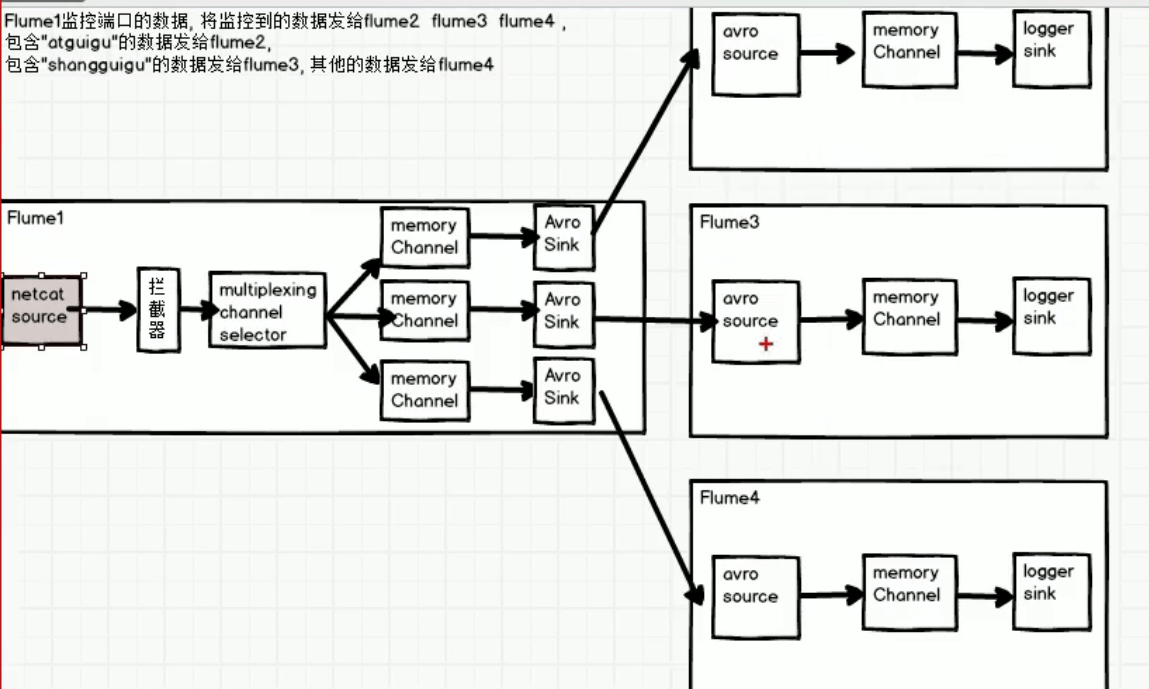
- 需求1实现步骤
主要分为两大步:
第一 使用拦截器对数据进行处理:对不同数据添加不同的head
第二:使用选择器将不同head的数据分发到不同的channel
(1)创建一个maven项目,并引入以下依赖。
<dependency>
<groupId>org.apache.flume</groupId>
<artifactId>flume-ng-core</artifactId>
<version>1.9.0</version>
</dependency>(2)定义CustomInterceptor类并实现Interceptor接口。将写好的代码打包jar,并放到flume的lib目录(/opt/module/flume)下。
package com.atguigu.flume.interceptor;
import org.apache.flume.Context;
import org.apache.flume.Event;
import org.apache.flume.interceptor.Interceptor;
import java.util.List;
public class CustomInterceptor implements Interceptor {
@Override
public void initialize() {
}
@Override
public Event intercept(Event event) {
byte[] body = event.getBody();
if (body[0] < 'z' && body[0] > 'a') {
event.getHeaders().put("type", "letter");
} else if (body[0] > '0' && body[0] < '9') {
event.getHeaders().put("type", "number");
}
return event;
}
@Override
public List<Event> intercept(List<Event> events) {
for (Event event : events) {
intercept(event);
}
return events;
}
@Override
public void close() {
}
public static class Builder implements Interceptor.Builder {
@Override
public Interceptor build() {
return new CustomInterceptor();
}
@Override
public void configure(Context context) {
}
}
}(3)编辑flume配置文件
为hadoop102上的Flume1配置1个netcat source,1个sink group(2个avro sink),并配置相应的ChannelSelector和interceptor。根据下面的配置,head里是letter就放c1,header是number就放c2。
a1.sources.r1.selector.mapping.letter = c1
a1.sources.r1.selector.mapping.number = c2
完整配置如下:
# Name the components on this agent
a1.sources = r1
a1.sinks = k1 k2
a1.channels = c1 c2
# Describe/configure the source
a1.sources.r1.type = netcat
a1.sources.r1.bind = localhost
a1.sources.r1.port = 44444
a1.sources.r1.interceptors = i1
a1.sources.r1.interceptors.i1.type = com.atguigu.flume.interceptor.CustomInterceptor$Builder
a1.sources.r1.selector.type = multiplexing
a1.sources.r1.selector.header = type
a1.sources.r1.selector.mapping.letter = c1
a1.sources.r1.selector.mapping.number = c2
# Describe the sink
a1.sinks.k1.type = avro
a1.sinks.k1.hostname = hadoop103
a1.sinks.k1.port = 4141
a1.sinks.k2.type=avro
a1.sinks.k2.hostname = hadoop104
a1.sinks.k2.port = 4242
# Use a channel which buffers events in memory
a1.channels.c1.type = memory
a1.channels.c1.capacity = 1000
a1.channels.c1.transactionCapacity = 100
# Use a channel which buffers events in memory
a1.channels.c2.type = memory
a1.channels.c2.capacity = 1000
a1.channels.c2.transactionCapacity = 100
# Bind the source and sink to the channel
a1.sources.r1.channels = c1 c2
a1.sinks.k1.channel = c1
a1.sinks.k2.channel = c2为hadoop103上的Flume4配置一个avro source和一个logger sink。
a1.sources = r1
a1.sinks = k1
a1.channels = c1
a1.sources.r1.type = avro
a1.sources.r1.bind = hadoop103
a1.sources.r1.port = 4141
a1.sinks.k1.type = logger
a1.channels.c1.type = memory
a1.channels.c1.capacity = 1000
a1.channels.c1.transactionCapacity = 100
a1.sinks.k1.channel = c1
a1.sources.r1.channels = c1为hadoop104上的Flume3配置一个avro source和一个logger sink。
a1.sources = r1
a1.sinks = k1
a1.channels = c1
a1.sources.r1.type = avro
a1.sources.r1.bind = hadoop104
a1.sources.r1.port = 4242
a1.sinks.k1.type = logger
a1.channels.c1.type = memory
a1.channels.c1.capacity = 1000
a1.channels.c1.transactionCapacity = 100
a1.sinks.k1.channel = c1
a1.sources.r1.channels = c1(4)分别在hadoop102,hadoop103,hadoop104上启动flume进程,注意先后顺序。
(5)在hadoop102使用netcat向localhost:44444发送字母和数字。
(6)观察hadoop103和hadoop104打印的日志。
4.3 负载均衡
负载均衡片处理器提供在多个Sink之间负载平衡的能力。实现支持通过round_robin(轮询)或者random(随机)参数来实现负载分发
默认情况下使用round_robin,但可以通过配置覆盖这个默认值。还可以通过集成AbstractSinkSelector类来实现用户自己的选择机制。
当被调用的时候,这选择器通过配置的选择规则选择下一个sink来调用。
1)案例需求
使用Flume1监控一个端口,将监控到的内容通过轮询或者随机的方式给到flume2和flume3。Flume2和Flume3将内容打印到控制台。这个时候需要使用LoadBalancingSinkProcessor。
2)架构分析:
具体架构选择见下图。
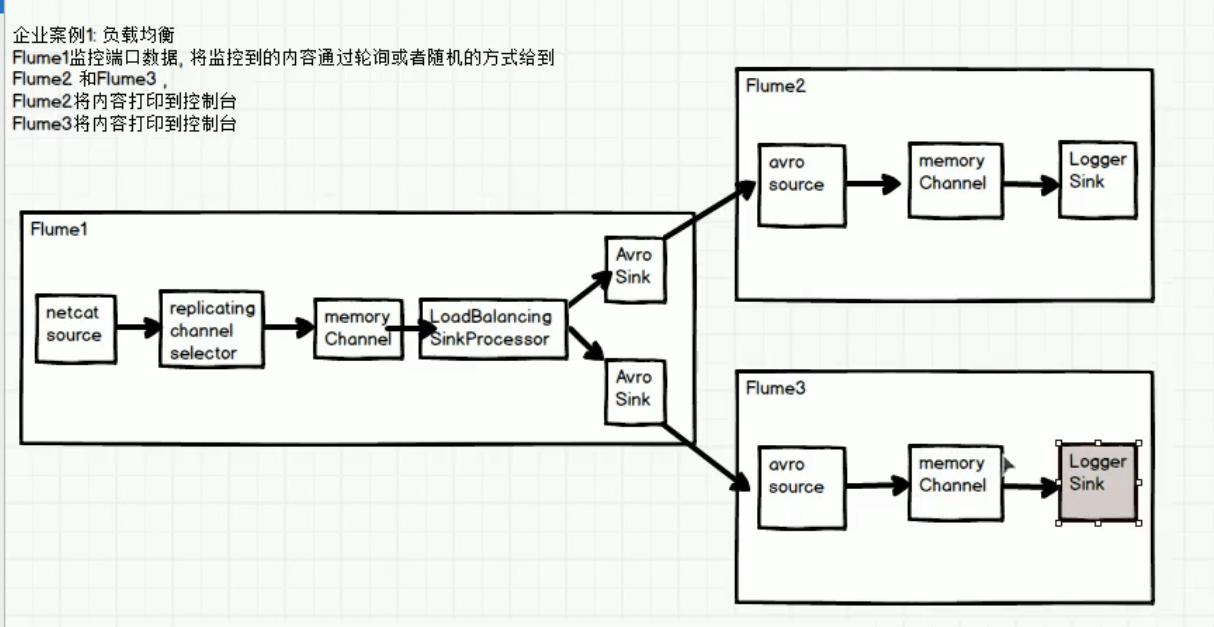
3)实现步骤
(1)准备工作
在/opt/module/flume/job目录下创建group3文件夹
[molly@hadoop102 job]$ cd group3/(2)创建flume-netcat-flume.conf:flume1的配置
配置1个netcat source和1个channel、1个sink group(2个sink),分别输送给flume-flume-console2和flume-flume-console3。
编辑配置文件
#负载均衡
#配置Agent a1的组件
a1.sources=r1
a1.channels=c1
a1.sinks=s1 s2
#配置a1的source
a1.sources.r1.type=netcat
a1.sources.r1.bind=0.0.0.0
a1.sources.r1.port=3333
##配置a1的channel
a1.channels.c1.type=memory
a1.channels.c1.capacity=1000
a1.channels.c1.trancactionCapacity=100
#配置a1的sink
a1.sinks.s1.type=avro
a1.sinks.s1.hostname=node2
a1.sinks.s1.port=8888
a1.sinks.s2.type=avro
a1.sinks.s2.hostname=node3
a1.sinks.s2.port=8888
#配置sink组以及sink处理器运行
a1.sinkgroups = g1
a1.sinkgroups.g1.sinks = s1 s2
a1.sinkgroups.g1.processor.type = load_balance
a1.sinkgroups.g1.processor.backoff = true
#参数可选round_robin(轮询)或者random(随机)
a1.sinkgroups.g1.processor.selector = round_robin
#绑定
a1.sources.r1.channels=c1
a1.sinks.s1.channel=c1
a1.sinks.s2.channel=c1(3)flume2和flume3的配置:两个配置是一样的.flume-flume-console2,flume-flume-console1
# 配置Agent a1的组件
a1.sources=r1
a1.channels=c1
a1.sinks=s1
# 配置a1的source
a1.sources.r1.type=avro
a1.sources.r1.bind=0.0.0.0
a1.sources.r1.port=8888
# 配置a1的channel
a1.channels.c1.type=memory
# 配置a1的sink
a1.sinks.s1.type=logger
# 绑定
a1.sources.r1.channels=c1
a1.sinks.s1.channel=c1(4)执行配置文件
分别开启对应配置文件:flume-flume-console2,flume-flume-console1,flume-netcat-flume。
[molly@hadoop102 flume]$ bin/flume-ng agent --conf conf/ --name a3 --conf-file job/group2/flume-flume-console2.conf -Dflume.root.logger=INFO,console
[molly@hadoop102 flume]$ bin/flume-ng agent --conf conf/ --name a2 --conf-file job/group2/flume-flume-console1.conf -Dflume.root.logger=INFO,console
[molly@hadoop102 flume]$ bin/flume-ng agent --conf conf/ --name a1 --conf-file job/group2/flume-netcat-flume.conf(6)使用netcat工具向本机的44444端口发送内容
$ nc localhost 44444(7)查看Flume2及Flume3的控制台打印日志
4.4 故障转移
1)案例需求
使用Flume1监控一个端口,其sink组中的sink分别对接Flume2和Flume3,采用FailoverSinkProcessor,实现故障转移的功能。
2)需求分析
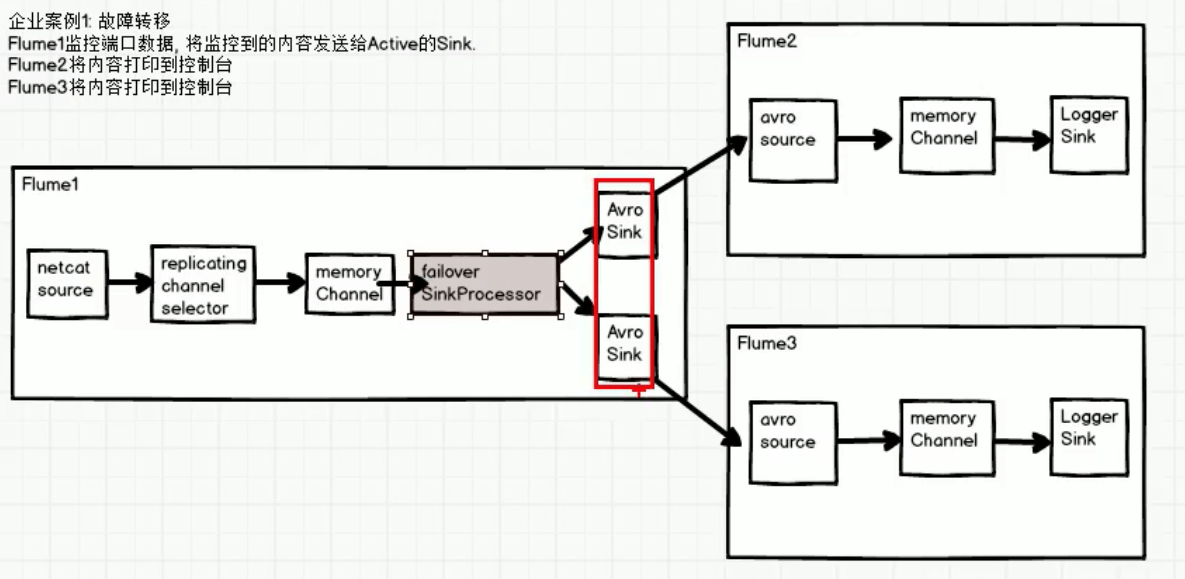
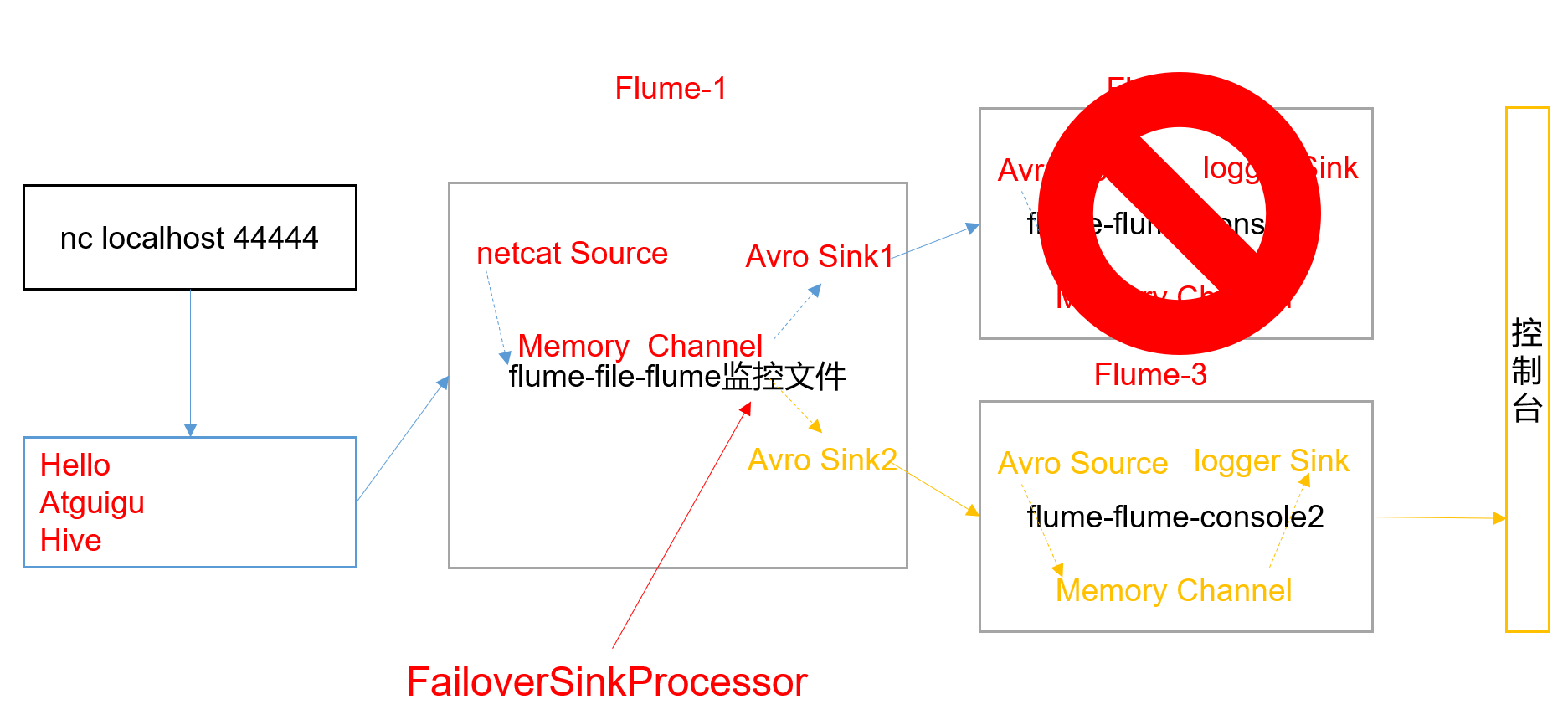 3)实现步骤
3)实现步骤
(1)准备工作
在/opt/module/flume/job目录下创建group2文件夹
[molly@hadoop102 job]$ cd group2/(2)创建flume-netcat-flume.conf
配置1个netcat source和1个channel、1个sink group(2个sink),分别输送给flume-flume-console1和flume-flume-console2。
编辑配置文件
[molly@hadoop102 group2]$ vim flume-netcat-flume.conf
#添加如下内容
# Name the components on this agent
a1.sources = r1
a1.channels = c1
a1.sinkgroups = g1
a1.sinks = k1 k2
# Describe/configure the source
a1.sources.r1.type = netcat
a1.sources.r1.bind = localhost
a1.sources.r1.port = 44444
#设置sinkgroups processor为failover
a1.sinkgroups.g1.processor.type = failover
#两个sink,k1与k2,其中2个优先级是5和10
a1.sinkgroups.g1.processor.priority.k1 = 5
a1.sinkgroups.g1.processor.priority.k2 = 10
#failover time的上限可以通过maxpenalty 属性来进行设置默认10s。
a1.sinkgroups.g1.processor.maxpenalty = 10000
# Describe the sink
a1.sinks.k1.type = avro
a1.sinks.k1.hostname = hadoop102
a1.sinks.k1.port = 4141
a1.sinks.k2.type = avro
a1.sinks.k2.hostname = hadoop102
a1.sinks.k2.port = 4142
# Describe the channel
a1.channels.c1.type = memory
a1.channels.c1.capacity = 1000
a1.channels.c1.transactionCapacity = 100
# Bind the source and sink to the channel
a1.sources.r1.channels = c1
a1.sinkgroups.g1.sinks = k1 k2
a1.sinks.k1.channel = c1
a1.sinks.k2.channel = c1(3)创建flume-flume-console1.conf
配置上级Flume输出的Source,输出是到本地控制台。
编辑配置文件
[molly@hadoop102 group2]$ vim flume-flume-console1.conf
#添加如下内容
# Name the components on this agent
a2.sources = r1
a2.sinks = k1
a2.channels = c1
# Describe/configure the source
a2.sources.r1.type = avro
a2.sources.r1.bind = hadoop102
a2.sources.r1.port = 4141
# Describe the sink
a2.sinks.k1.type = logger
# Describe the channel
a2.channels.c1.type = memory
a2.channels.c1.capacity = 1000
a2.channels.c1.transactionCapacity = 100
# Bind the source and sink to the channel
a2.sources.r1.channels = c1
a2.sinks.k1.channel = c1(4)创建flume-flume-console2.conf
配置上级Flume输出的Source,输出是到本地控制台。
编辑配置文件
[molly@hadoop102 group2]$ vim flume-flume-console2.conf
添加如下内容
# Name the components on this agent
a3.sources = r1
a3.sinks = k1
a3.channels = c2
# Describe/configure the source
a3.sources.r1.type = avro
a3.sources.r1.bind = hadoop102
a3.sources.r1.port = 4142
# Describe the sink
a3.sinks.k1.type = logger
# Describe the channel
a3.channels.c2.type = memory
a3.channels.c2.capacity = 1000
a3.channels.c2.transactionCapacity = 100
# Bind the source and sink to the channel
a3.sources.r1.channels = c2
a3.sinks.k1.channel = c2(5)执行配置文件
分别开启对应配置文件:flume-flume-console2,flume-flume-console1,flume-netcat-flume。
[molly@hadoop102 flume]$ bin/flume-ng agent --conf conf/ --name a3 --conf-file job/group2/flume-flume-console2.conf -Dflume.root.logger=INFO,console
[molly@hadoop102 flume]$ bin/flume-ng agent --conf conf/ --name a2 --conf-file job/group2/flume-flume-console1.conf -Dflume.root.logger=INFO,console
[molly@hadoop102 flume]$ bin/flume-ng agent --conf conf/ --name a1 --conf-file job/group2/flume-netcat-flume.conf(6)使用netcat工具向本机的44444端口发送内容
$ nc localhost 44444(7)查看Flume2及Flume3的控制台打印日志
因为k1的优先级是5,K2是10因此当K2正常运行的时候,是发送到K2的。
(8)将Flume2 kill,观察Flume3的控制台打印情况。
我们发现源代理发生事件到K2失败,然后他将K2放入到failover list(故障列表)
因为K1还是正常运行的,因此这个时候他会接收到数据。
注:使用jps -ml查看Flume进程。
4.5聚合
1)案例需求:
hadoop102上的Flume-1监控文件/opt/module/group.log,
hadoop103上的Flume-2监控某一个端口的数据流,
Flume-1与Flume-2将数据发送给hadoop104上的Flume-3,Flume-3将最终数据打印到控制台。
2)需求分析

3)实现步骤:
(1)准备工作
分发Flume
[molly@hadoop102 module]$ xsync flume
在hadoop102、hadoop103以及hadoop104的/opt/module/flume/job目录下创建一个group3文件夹。
[molly@hadoop102 job]$ mkdir group3
[molly@hadoop103 job]$ mkdir group3
[molly@hadoop104 job]$ mkdir group3
(2)创建flume1-logger-flume.conf
配置Source用于监控hive.log文件,配置Sink输出数据到下一级Flume。
在hadoop102上编辑配置文件
[molly@hadoop102 group3]$ vim flume1-logger-flume.conf
添加如下内容
# Name the components on this agent
a1.sources = r1
a1.sinks = k1
a1.channels = c1
# Describe/configure the source
a1.sources.r1.type = exec
a1.sources.r1.command = tail -F /opt/module/group.log
a1.sources.r1.shell = /bin/bash -c
# Describe the sink
a1.sinks.k1.type = avro
a1.sinks.k1.hostname = hadoop104
a1.sinks.k1.port = 4141
# Describe the channel
a1.channels.c1.type = memory
a1.channels.c1.capacity = 1000
a1.channels.c1.transactionCapacity = 100
# Bind the source and sink to the channel
a1.sources.r1.channels = c1
a1.sinks.k1.channel = c1
(3)创建flume2-netcat-flume.conf
配置Source监控端口44444数据流,配置Sink数据到下一级Flume:
在hadoop103上编辑配置文件
[molly@hadoop102 group3]$ vim flume2-netcat-flume.conf
添加如下内容
# Name the components on this agent
a2.sources = r1
a2.sinks = k1
a2.channels = c1
# Describe/configure the source
a2.sources.r1.type = netcat
a2.sources.r1.bind = hadoop103
a2.sources.r1.port = 44444
# Describe the sink
a2.sinks.k1.type = avro
a2.sinks.k1.hostname = hadoop104
a2.sinks.k1.port = 4141
# Use a channel which buffers events in memory
a2.channels.c1.type = memory
a2.channels.c1.capacity = 1000
a2.channels.c1.transactionCapacity = 100
# Bind the source and sink to the channel
a2.sources.r1.channels = c1
a2.sinks.k1.channel = c1
(4)创建flume3-flume-logger.conf
配置source用于接收flume1与flume2发送过来的数据流,最终合并后sink到控制台。
在hadoop104上编辑配置文件
[molly@hadoop104 group3]$ touch flume3-flume-logger.conf
[molly@hadoop104 group3]$ vim flume3-flume-logger.conf
添加如下内容
# Name the components on this agent
a3.sources = r1
a3.sinks = k1
a3.channels = c1
# Describe/configure the source
a3.sources.r1.type = avro
a3.sources.r1.bind = hadoop104
a3.sources.r1.port = 4141
# Describe the sink
# Describe the sink
a3.sinks.k1.type = logger
# Describe the channel
a3.channels.c1.type = memory
a3.channels.c1.capacity = 1000
a3.channels.c1.transactionCapacity = 100
# Bind the source and sink to the channel
a3.sources.r1.channels = c1
a3.sinks.k1.channel = c1
(5)执行配置文件
分别开启对应配置文件:flume3-flume-logger.conf,flume2-netcat-flume.conf,flume1-logger-flume.conf。
[molly@hadoop104 flume]$ bin/flume-ng agent –conf conf/ –name a3 –conf-file job/group3/flume3-flume-logger.conf -Dflume.root.logger=INFO,console
[molly@hadoop102 flume]$ bin/flume-ng agent –conf conf/ –name a2 –conf-file job/group3/flume1-logger-flume.conf
[molly@hadoop103 flume]$ bin/flume-ng agent –conf conf/ –name a1 –conf-file job/group3/flume2-netcat-flume.conf
(6)在hadoop103上向/opt/module目录下的group.log追加内容
[molly@hadoop103 module]$ echo ‘hello’ > group.log
(7)在hadoop102上向44444端口发送数据
[molly@hadoop102 flume]$ telnet hadoop102 44444
(8)检查hadoop104上数据
